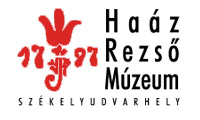Kovács Petronella (szerk.): Isis - Erdélyi magyar restaurátor füzetek 10. (Székelyudvarhely, 2010)
B. Perjés Judit - Domokos Levente - Puskás Katalin: Tíz nap a "Nagy-Küküllő felső folyása mentén" avagy hazi és vendég restaurátorok a székelykeresztúri Molnár István Múzeum születő állandó kiállításán
materials - leather cover, metal straps and nails - were replaced. Regrettably we cannot yet say that this does not happen in museums. Petronella Kovács DLA Wood and furniture conservator MA Head of the Department of Conservation Training and Research Hungarian National Museum Head of the Faculty of Applied Arts Object Conservation Hungarian University of Fine Arts Budapest Phone: + 36-1-323-1423 E-mail: kovacs.petronella@gmail.com Enikő Sipos Textile conservation case studies The decomposition of archaeological textile is a very complex process, which is determined by the interaction of physical, chemical and biological factors between the object and its environment beside common wearing, tearing and deformation. They are often contradictory and extremely complicated processes. Organic materials, mineral salts, gases, ground water, which can be found in various quantities in the soil, and the pH value of the soil also play an important role in the decomposition processes. Decomposition cannot practically be stopped but it can be slowed down with creating an adequate environment. It has often been proved that stabile climatic circumstances are more favourable for every object than constant environmental changes. This is why it is important to store the excavation fabrics until the conservation within an environment of the same temperature and moisture content as at the site. Historical and archaeological textiles are the most sensitive material relics and they also perish the fastest. No general outlines can be given concerning their treatment and conservation since every object is different and they must be treated as unique objects. As every object is unique, it is difficult to find a method that can universally be used. Through these case studies, we illustrate the treatment methods of various object types. Two 16th century ladies’wear, a 16th century headdress, the remains of the grave-clothes of Ernő Vas prince of Styria, and a possible manufacturing technique of the Hungarian coronation mantle will be discussed in the followings. We have chosen these items because the treatment of excavation materials is significantly different from those that were not recovered from the earth. We intend to speak about the coronation mantle because it was not conserved in a classical sense. As it is a national relic, the repairs, modification and completions of the object have a historical value and they had to be preserved. In this case, conservation meant the determination of the materials of the object, the description of the various manufacturing techniques and the assessment of the missing areas and the condition of the object. Enikő Sipos Textilconservator MA Hungarian National Museum Budapest Phone: +36-1-338-2122 E-mail: siposeni@gmail.com Katalin Orosz Possibilities of the analysis of painted paper objects and conclusions drawn from certain analytical results Huge amounts of painted, printed paper objects and paper-based documents are preserved in public collections. The determination of the materials and the condition of the coloured layers is important from art historical, technical historical and conservation aspects but it is generally a complicated task needing much background information and the co-operation of specialists of various fields. The planning, carrying out and ordering of the necessary analyses, the comparison and evaluation of the results are the tasks of the conservator. The objectives of the analyses and the information we would like to get by them must always be formulated before the determination of the series of analyses. It is important to consider if the risk of an intervention (e.g. sampling or the movement of the object) and the information we expect are proportionate. Before the determination of the analysis series, the conservator must learn about the contemporary manufacturing technologies. The pieces of information gained with various methods must be compared and summed up and if necessary, the series of analyses must be modified. The author shows in the study the aspects of planning a series of analyses, the types of information that can be got from various analyses (scrutiny, optical, microanalytical and instrumental analytical), and the process of summing up of the analytical results. The author illustrates the analytical process through the analyses she carried out within the frames of her doctoral thesis on Georgius Agricola’s work on mining titled „De re metallica” printed in German language in 1557. The volume preserved in the Central Library of the National Archives of Hungary contains 292 illustrations. The significance of the examined volume lies in the fact that the illustrations, which occupy half a page or an entire page, were painted with green, blue, red, yellow, ochre, black, grey, brown, beige and white colours. There are no data about the person who painted the volume and the date of the painting but it does not match any of the other 3 painted volumes preserved in Hungary. The 189
